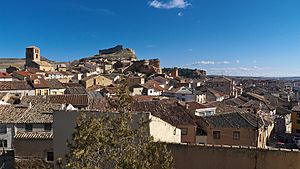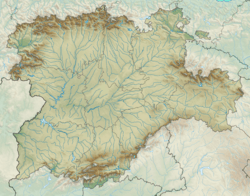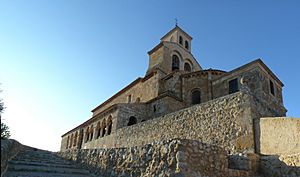San Esteban de Gormaz facts for kids
Quick facts for kids
San Esteban de Gormaz
|
|||
|---|---|---|---|
 |
|||
|
|||
| Country | |||
| Autonomous community | |||
| Province | |||
| Area | |||
| • Total | 406.71 km2 (157.03 sq mi) | ||
| Population
(2018)
|
|||
| • Total | 3,010 | ||
| • Density | 7.401/km2 (19.17/sq mi) | ||
| Time zone | UTC+1 (CET) | ||
| • Summer (DST) | UTC+2 (CEST) | ||
San Esteban de Gormaz is a charming town in Spain. It's located in the province of Soria, within the region of Castile-Leon. About 3,500 people live here. This town is special because it's on important historical paths, like the Wool Route and the Way of the Cid, which follows the journey of a famous Spanish hero.
San Esteban de Gormaz sits by the Duero River, nestled against a small hill. It's about 70 kilometers west of Soria, the main city of the province. Close by, you can find the ancient Arab Gormaz Castle.
Contents
A Look at San Esteban de Gormaz History
San Esteban de Gormaz has a very long history. People have lived in this area since prehistoric times. Both the Romans and the Arabs built settlements here. You can still see some of their old buildings and structures today.
San Esteban de Gormaz in Arab Times
The Arabs thought San Esteban de Gormaz was a very important Christian center. Because of this, it became a military target for about 200 years. The Arabs started building its castle in the 9th century. Back then, the town was called Castromoro.
Many battles took place here until the town finally became part of the Kingdom of Castile. All these fights helped San Esteban de Gormaz grow into a strong town on the border of Castile.
Growing Importance of the Town
In 1187, a very important meeting happened in San Esteban de Gormaz. The first Cortes of Castile were held here. These were like early parliaments where important decisions were made.
The town continued to grow and became very successful until the late 1200s. At its peak, about 3,000 people lived there. It had many parishes (local churches) and two monasteries (places where monks lived) just outside the town walls.
Later Years and Modern Times
After the 13th century, the town slowly became less important. It went through tough times with poverty and a smaller population. This continued until the 20th century.
However, in recent times, San Esteban de Gormaz has started new projects to bring in industries. This has helped the town grow again. The population has increased, reaching levels similar to its best historical periods.
Villages in the Municipality
The municipality of San Esteban de Gormaz includes several smaller villages. These villages are part of the larger area governed by the town. Some of them are:
- Aldea de San Esteban
- Atauta
- Inés
- Matanza de Soria
- Olmillos
- Pedraja de San Esteban
- Rejas de San Esteban
- Velilla de San Esteban
See also
 In Spanish: San Esteban de Gormaz para niños
In Spanish: San Esteban de Gormaz para niños






